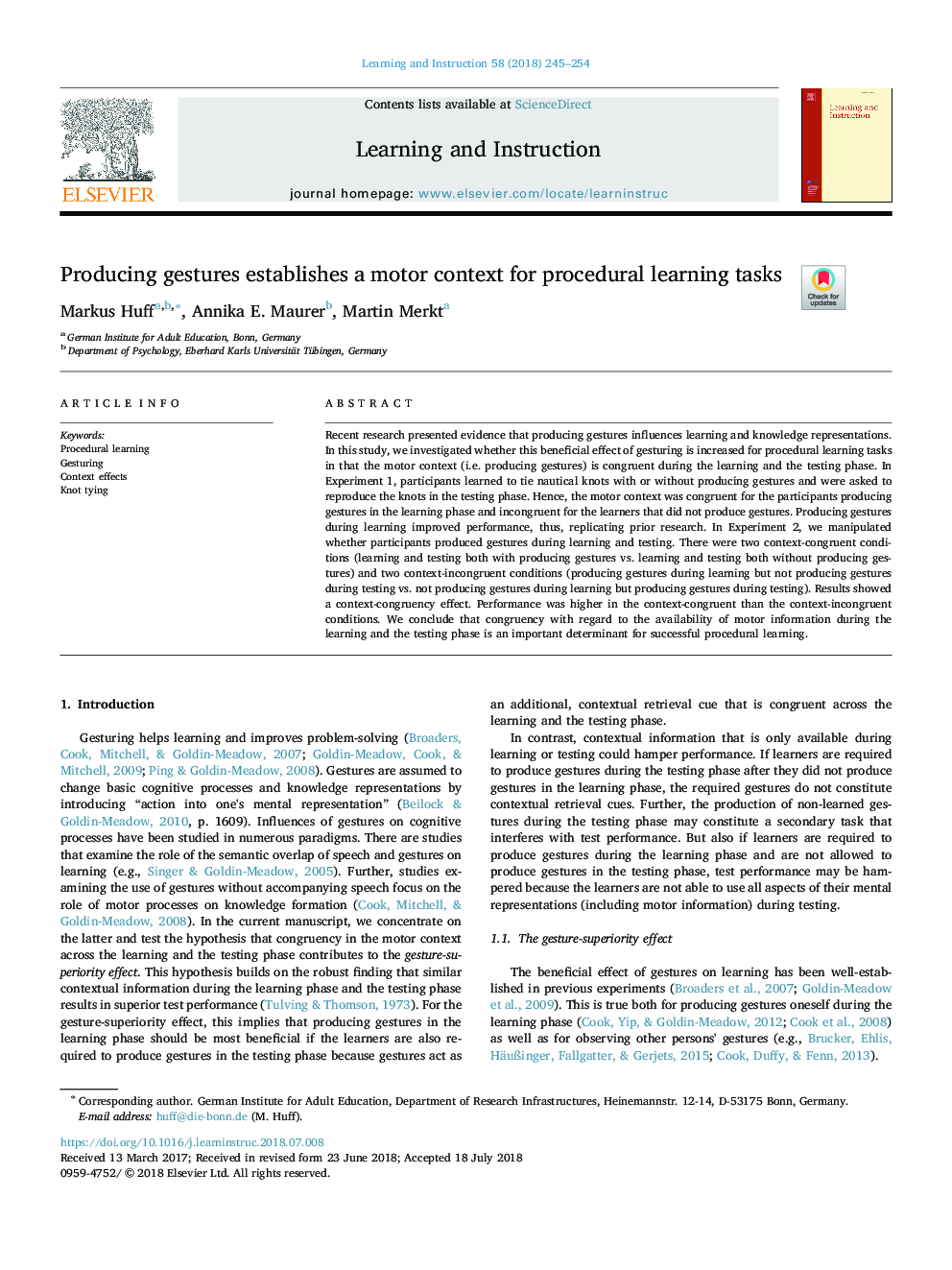| کد مقاله | کد نشریه | سال انتشار | مقاله انگلیسی | نسخه تمام متن |
|---|---|---|---|---|
| 6845449 | 1436403 | 2018 | 10 صفحه PDF | دانلود رایگان |
عنوان انگلیسی مقاله ISI
Producing gestures establishes a motor context for procedural learning tasks
ترجمه فارسی عنوان
تولید حرکات ایجاد زمینه موتور برای وظایف یادگیری رویه است
دانلود مقاله + سفارش ترجمه
دانلود مقاله ISI انگلیسی
رایگان برای ایرانیان
کلمات کلیدی
یادگیری رویه ای، زگیل، اثرات زمینه، اتصال گره،
ترجمه چکیده
تحقیقات اخیر شواهدی ارائه دادند که تولید حرکات روی نمایشهای یادگیری و دانش تاثیر می گذارد. در این مطالعه، ما بررسی کردیم که آیا این اثر مفیدی از ججنجی برای وظایف یادگیری رویه ای افزایش می یابد، در حالی که زمینه حرکت (یعنی تولید حرکات) در مرحله یادگیری و تست هماهنگ است. در آزمایش 1، شرکت کنندگان یاد گرفتند که گره های دریایی را با یا بدون تولید حرکات متصل کنند و از آنها خواسته شد که گره ها را در مرحله تست بازتولید کنند. از این رو، زمینه موتور برای شرکت کنندگان تولید حرکات در مرحله یادگیری و عدم هماهنگی برای یادگیرندگان است که حرکات تولید نکردند. تولید حرکات در طول یادگیری بهبود عملکرد، بنابراین، تکرار تحقیقات قبلی. در آزمایش 2 ما دستکاری کردیم که آیا شرکت کنندگان حرکات را در طول یادگیری و تست تولید می کنند. دو شرایط سازگار با محیط زیست وجود داشت (یادگیری و تست هر دو با تولید حرکات در مقابل یادگیری و تست هر دو بدون تولید حرکات) و دو شرایط غیر متقابل (ایجاد حرکات در طول یادگیری اما تولید حرکات در طی تست و تولید حرکات در طول یادگیری اما تولید حرکات در طول آزمایش) نتایج نشان داد که اثر متقابل متناقض است. عملکرد در شرایط متناسب با شرایط غیرمستقیم بالاتر بود. ما نتیجه می گیریم که انطباق با توجه به دسترسی به اطلاعات موتور در طول یادگیری و مرحله تست، یک عامل مهم برای یادگیری روند رویه ای است.
موضوعات مرتبط
علوم انسانی و اجتماعی
روانشناسی
روانشناسی رشد و آموزشی
چکیده انگلیسی
Recent research presented evidence that producing gestures influences learning and knowledge representations. In this study, we investigated whether this beneficial effect of gesturing is increased for procedural learning tasks in that the motor context (i.e. producing gestures) is congruent during the learning and the testing phase. In Experiment 1, participants learned to tie nautical knots with or without producing gestures and were asked to reproduce the knots in the testing phase. Hence, the motor context was congruent for the participants producing gestures in the learning phase and incongruent for the learners that did not produce gestures. Producing gestures during learning improved performance, thus, replicating prior research. In Experiment 2, we manipulated whether participants produced gestures during learning and testing. There were two context-congruent conditions (learning and testing both with producing gestures vs. learning and testing both without producing gestures) and two context-incongruent conditions (producing gestures during learning but not producing gestures during testing vs. not producing gestures during learning but producing gestures during testing). Results showed a context-congruency effect. Performance was higher in the context-congruent than the context-incongruent conditions. We conclude that congruency with regard to the availability of motor information during the learning and the testing phase is an important determinant for successful procedural learning.
ناشر
Database: Elsevier - ScienceDirect (ساینس دایرکت)
Journal: Learning and Instruction - Volume 58, December 2018, Pages 245-254
Journal: Learning and Instruction - Volume 58, December 2018, Pages 245-254
نویسندگان
Markus Huff, Annika E. Maurer, Martin Merkt,
